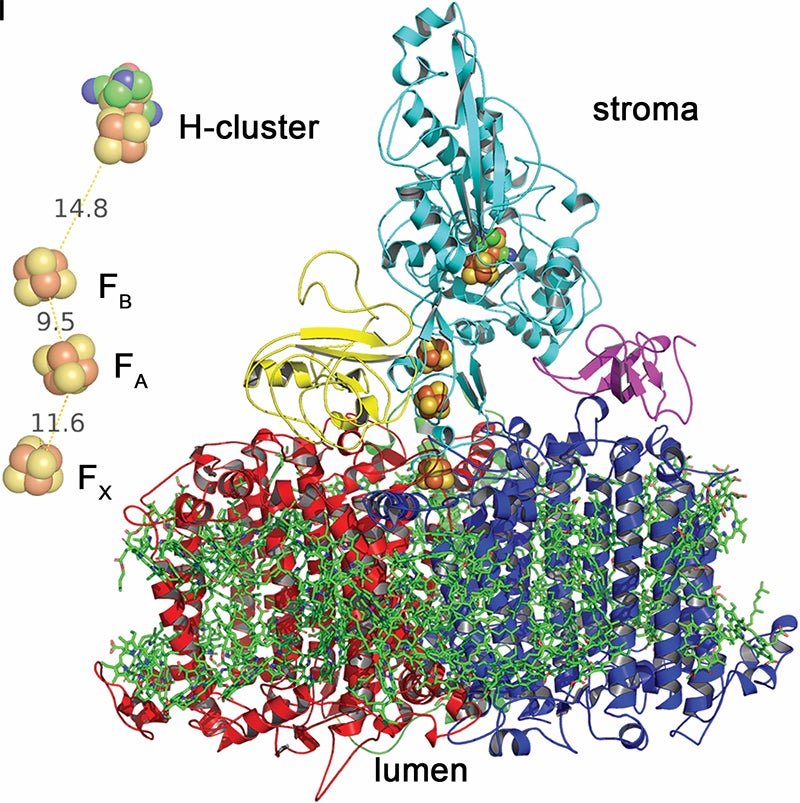ASU scientists rewire photosynthesis to fuel our future

Professor Kevin Redding (left) with doctoral student Andrey Kanygin. Photo by Mary Zhu
Hydrogen is an essential commodity with over 60 million tons produced globally every year. However, more than 95% of it is made by steam reformation of fossil fuels, a process that is energy intensive and produces carbon dioxide. If we could replace even a part of that with algal biohydrogen that is made via light and water, it would have a substantial impact.
This is essentially what has just been achieved in the lab of Kevin Redding, professor in Arizona State University's School of Molecular Sciences and director of the Center for Bioenergy and Photosynthesis.
The center's research, titled "Rewiring photosynthesis: a Photosystem I -hydrogenase chimera that makes hydrogen in vivo," was published in the high-impact journal Energy and Environmental Science.
“What we have done is to show that it is possible to intercept the high-energy electrons from photosynthesis and use them to drive alternate chemistry, in a living cell,” Redding said. “We have used hydrogen production here as an example.”
“Kevin Redding and his group have made a true breakthrough in reengineering the Photosystem I complex,” said Ian Gould, interim director of the School of Molecular Sciences, which is part of The College of Liberal Arts and Sciences. “They didn't just find a way to redirect a complex protein structure that nature designed for one purpose to perform a different, but equally critical process, but they found the best way to do it at the molecular level.”
It is common knowledge that plants and algae, as well as cyanobacteria, use photosynthesis to produce oxygen and “fuels,” the latter being oxidizable substances like carbohydrates and hydrogen. There are two pigment-protein complexes that orchestrate the primary reactions of light in oxygenic photosynthesis: Photosystem I (PSI) and Photosystem II (PSII).
Algae possess an enzyme called hydrogenase that uses electrons it gets from the protein ferredoxin, which is normally used to ferry electrons from PSI to various destinations. A problem is that the algal hydrogenase is rapidly and irreversibly inactivated by oxygen that is constantly produced by PSII.
In this study, doctoral student and first author Andrey Kanygin has created a genetic chimera of PSI and the hydrogenase such that they co-assemble and are active in vivo. This new assembly redirects electrons away from carbon dioxide fixation to the production of biohydrogen.

A model of Photosystem 1 core subunits
“We thought that some radically different approaches needed to be taken — thus, our crazy idea of hooking up the hydrogenase enzyme directly to Photosystem I in order to divert a large fraction of the electrons from water splitting, by Photosystem II, to make molecular hydrogen,” Redding said.
Cells expressing the new photosystem (PSI-hydrogenase) make hydrogen at high rates in a light-dependent fashion for several days.
This result will also be featured in an upcoming article in Chemistry World, a monthly chemistry news magazine published by the Royal Society of Chemistry. The magazine addresses current developments in the world of chemistry, including research, international business news and government policy as it affects the chemical science community.
The team included Kevin E. Redding, Andrey Kanygin and Patricia Baker of ASU, Kiera Reifschneider (formerly Redding’s doctoral student), Iftach Yacoby and Yuval Milrad of Tel Aviv University and Chandrasekhar Thummala of Yogi Vemana University, India (formerly a visiting professor in Redding’s lab).This work was funded by the National Science Foundation, grant number CBET-1706960.
More Science and technology

Will this antibiotic work? ASU scientists develop rapid bacterial tests
Bacteria multiply at an astonishing rate, sometimes doubling in number in under four minutes. Imagine a doctor faced with a…

ASU researcher part of team discovering ways to fight drug-resistant bacteria
A new study published in the Science Advances journal featuring Arizona State University researchers has found…

ASU student researchers get early, hands-on experience in engineering research
Using computer science to aid endangered species reintroduction, enhance software engineering education and improve semiconductor…